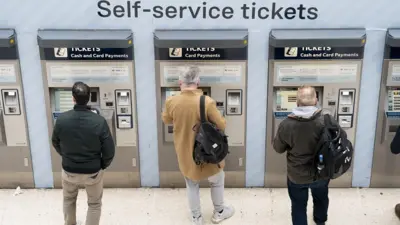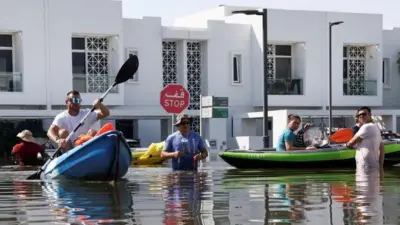We've updated our Privacy and Cookies Policy
We've made some important changes to our Privacy and Cookies Policy and we want you to know what this means for you and your data.
US election 2020: What to look out for on election night
Image source, Getty Images
Americans are choosing whether Donald Trump or Joe Biden will be the next US president.
Here's what to watch for as an unpredictable election night unfolds, and the results roll in.
Some key details:
- To become US president, you don't actually need to win the popular vote. Instead, candidates are aiming to win the majority in something called the electoral college (more on that below)
- Millions more Americans are voting by mail than in previous elections. Counting postal votes can take more time, and some states won't start until polling day, so there will almost certainly be delays for some results.
- And because of this unprecedented surge of postal votes, a candidate who takes an early lead may end up being overtaken as postal or in-person votes are tallied. So be wary of the numbers.
Some key terms:
- Bellwether state: Places like Ohio and Missouri where voters have proven reliable at choosing the national winner
- Exit poll: Interviews with voters after they have voted. These include people who vote on the day and early voters. Only a small number of voters are interviewed, so the exit poll result can turn out to be different to the official count.
- Electoral college: Each state gets a number of electors, roughly in proportion to its population. In most cases, whichever candidate wins a state also wins all that state's electors, who meet later to choose the president and vice-president. Because there are 538 electoral college votes, each candidate needs 270 to win. There's a full explanation of the system here.
- Projecting winners: This is what the night is all about but how does it work? It's a combination of in-person interviews with voters at polling stations, telephone interviews with early voters and actual votes counted in precincts. Major US networks will project (they may use the term "call") winners of states when all this data shows a candidate has an unbeatable lead. In all cases, these are predictions and not official results, which usually take weeks. (More on projecting below)
- Swing state or battleground state: These states lack a clear party affiliation, meaning they are up for grabs for both Democratic and Republican candidates.
- Red state v blue state: These states tend to vote with a particular party - Republicans in red states and Democrats in blue.
How to know who's winning
The influx of postal ballots this year will make it hard to see who's in the lead early on.
Different states have different rules for how - and when - to count postal ballots, meaning there will be large gaps between them in terms of reporting results. Some states, like Florida and Arizona, begin pre-processing ballots weeks before 3 November. Others, like Wisconsin and Pennsylvania, won't touch these votes until election day, meaning they'll likely be slower to count.
To add to the confusion, states differ in their deadlines for when to accept postal ballots. Some, like Georgia, will only count ballots received on or before 3 November, while others, like Ohio, will count late ballots as long as they are postmarked by 3 November.
If some of the contests in the battleground states are close, then we might not know those results - and therefore the overall winner - until much later, possibly for several days.
This hasn't been the case in past elections, when you could typically set your watch to the 23:00 EST (04:00 GMT) closure of West Coast polls. In 2008, results came right on the hour and in 2012 they were just 15 minutes after that.
The last time around, however, it wasn't until Donald Trump clinched Pennsylvania deep into election night - 01:35 EST (06:35 GMT) - that his victory over Hillary Clinton was considered inevitable.
Watch out for these two main things:
Firstly, early tallies may be deceptive.
This is due in part to more differences between states in reporting. In some states, ballots cast in person on election day will be counted first. These counts are expected to favour Mr Trump, as his supporters are expected to be more likely to vote on the day.
In other places, postal votes cast prior to 3 November will be reported first or included in early counts along with day-of votes. Initial results from these states may favour Mr Biden, as Democrats are more likely than Republicans to vote by mail this year.
There's also the looming concern of electoral fraud - a common refrain from the Trump campaign.
Importantly, instances of electoral fraud are incredibly rare, and there is no evidence that postal ballots are especially susceptible. Overall, the rate of voting fraud in the US is between 0.00004% and 0.0009%, according to a 2017 study by the Brennan Center for Justice.
How results are projected
After the polls close, major US media outlets will be using election models to estimate who will win all the different races. The models draw on a variety of data such as exit polls (interviews with voters at polling stations, phone interviews with early voters) and actual votes counted by local officials and then fed into a database.
A state will be "projected" (you may hear the term "called" as well) by these media outlets when they believe a candidate has an unassailable lead. Some describe it as a 99.5% certainty.
This year, the BBC gets its data from polling firm Edison Research who do the field work for the exit polls and work with US networks in the National Election Pool. The watchword from all this year is caution - there is no race to be first. If the BBC and its partners don't believe there is enough data to project a winner of any state, we won't do so - even if others are.
The same is true when the presidential election is called, or projected, for a candidate. It will take weeks for states to count all the ballots and that has always been the case but even more likely this time due to postal voting.
Last time around, in 2016, Hillary Clinton's lead in the popular vote widened for more than a month after election day as officials counted ballots, many from California, even though Mr Trump had already won enough states to claim the presidency.
Why do postal votes cause delays?
Tens of millions of postal ballots will be cast in this year's election - perhaps double the number in 2016.
There were concerns that the sheer volume of mail-in ballots would overwhelm the country's postal service, delaying delivery and receipt by state officials. But the postal service has assured that's not the case.
Some states will accept ballots that arrive well after election day - as long as they are postmarked on or before 3 November - which will further slow down the count.
And once they have arrived, postal votes take longer to count than in-person ballots. Postal ballots must be manually removed from their envelopes and verified as valid before they can be tabulated.
What happens if there is no clear winner?
If there are no clear results on 3 November we'll have to wait days - or weeks - for vote counting to finish up.
This is normal - votes are typically tallied late on election night and early into the next day. But we're expecting it to take even longer this year.
Plus, there could be legal disputes which will add to the uncertainty and could mean the courts play a part.
States to watch
We know that final results will be slow, but there are still some states that may give us early clues.
The first swing state to report its first tranche could be Georgia, where polls close at 19:00 EST (midnight GMT) and then half an hour later it's North Carolina at 19:30 EST (00:30 GMT), where a large number of early in-person voters means projections could come quickly. Here, the overwhelming majority of results are expected by the end of the night. Donald Trump narrowly won this state in 2016 and it is a toss-up between parties once again. A win here for Mr Trump or Mr Biden could mean a good night ahead.
Soon after, at 20:00 EST (01:00 GMT) the last polls will close in Ohio and Florida. Ohio is not just a swing state, it is also a presidential fortune-teller: it has backed the winner at every presidential contest bar one since World War Two. But if it's close in Ohio, don't expect a projected winner on the night.
Florida is perhaps one of the night's biggest prizes, and we expect the first set of results to be announced shortly after 20:30 EST (01:30 GMT). White House races have been won and lost in this battleground state, and the same may be true this year. A note of caution - early in-person and postal ballots will be reported first in Florida and these will likely favour Mr Biden.
Another titan of US elections is Texas. Like Georgia, it's rarely considered Democratic territory but demographical trends mean Texas has moved closer in their direction over recent years. Polls close at 21:00 EST (02:00 GMT) and we should get plenty of results from counties there through the night.
And at 21:00 EST (02:00 GMT), polls will shutter in Arizona, where officials began counting ballots on 20 October. Mail ballots that arrived after 1 November will not be counted until after election day, so if this state is close a projection will be slow. Trump was victorious here in 2016, but national polls now give Mr Biden a razor's-edge lead.
In a number of other states, officials will not count a single ballot until 3 November. So expect a wait.
Polls in Pennsylvania will close at 20:00 EST (01:00 GMT) on election day. Both candidates' likely path to the White House will run through this battleground state, the place where Mr Biden was born and which Mr Trump won in 2016 by a single percentage point. Legal challenges may be likely in this crucial state.
In both Wisconsin and Michigan, polls will close at 21:00 EST (02:00 GMT). Democrats have been hard at work in Wisconsin after Hillary Clinton's narrow loss there in 2016. Many polls now give Mr Biden the lead, but the state is still up for grabs. The most populous county Milwaukee is due in the early hours of Wednesday. Neighbouring Michigan - another swing state - will also be closely watched, but a projection there could be days away.
The other elections
Biden and Trump aren't the only two people on the ballot.
Both parties will be paying close attention to elections for the US Senate - where Republicans currently hold a narrow, three-seat advantage.
Trump ally Lindsey Graham is in the fight of his political life in South Carolina, facing a stiff challenge from Democrat Jaime Harrison. Mr Graham, has held this seat since 2003, but he has turned away some voters with his staunch loyalty to the president. Final polls give Mr Graham a two-point edge, and he is still favourite to win but the narrow margin was unexpected and suggests there is plenty anti-Trump sentiment in a typically conservative state.
In Maine, Republican Susan Collins may soon be out of a job. Ms Collins is one of the few moderate members of her party in office right now, but she still may be punished for her affiliation to the president in a state where he is deeply unpopular.
As well as the Senate, all seats in the lower House of Representatives are also up for election.
And that's not all. Americans will also weigh in on more than 100 ballot measures. In California, a referendum is looking to overturn a law which eliminates cash bail entirely, and replaces it with a pre-trial risk assessment.
Marijuana is on the ballot in Arizona, Montana, New Jersey and South Dakota, where voters could legalise cannabis for recreation purposes. Similarly, in Mississippi, voters may cast their ballots to approve marijuana for medical purposes.
- Eat your way to power! Can a bacon sandwich affect your chances?
- Battle for the White House: Clive Myrie investigates what divides Americans (UK only)
Top Stories
Features & Analysis
Most read
Content is not available








